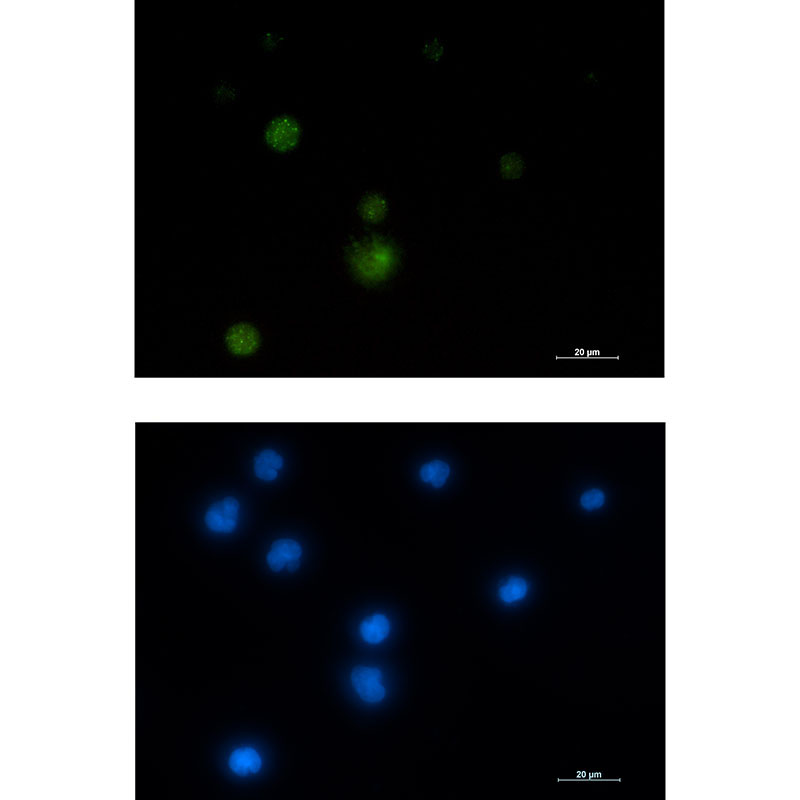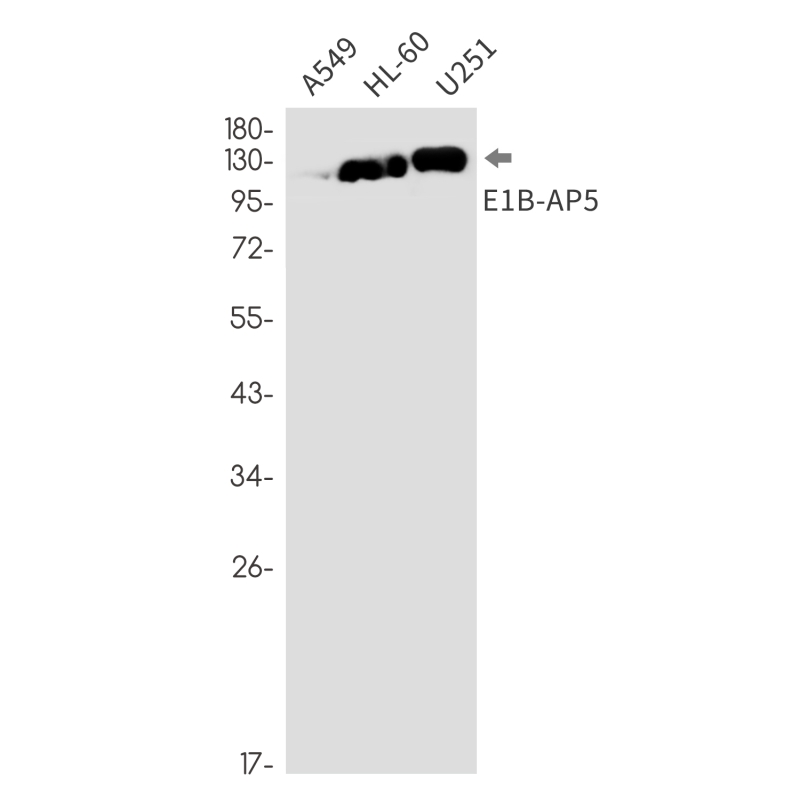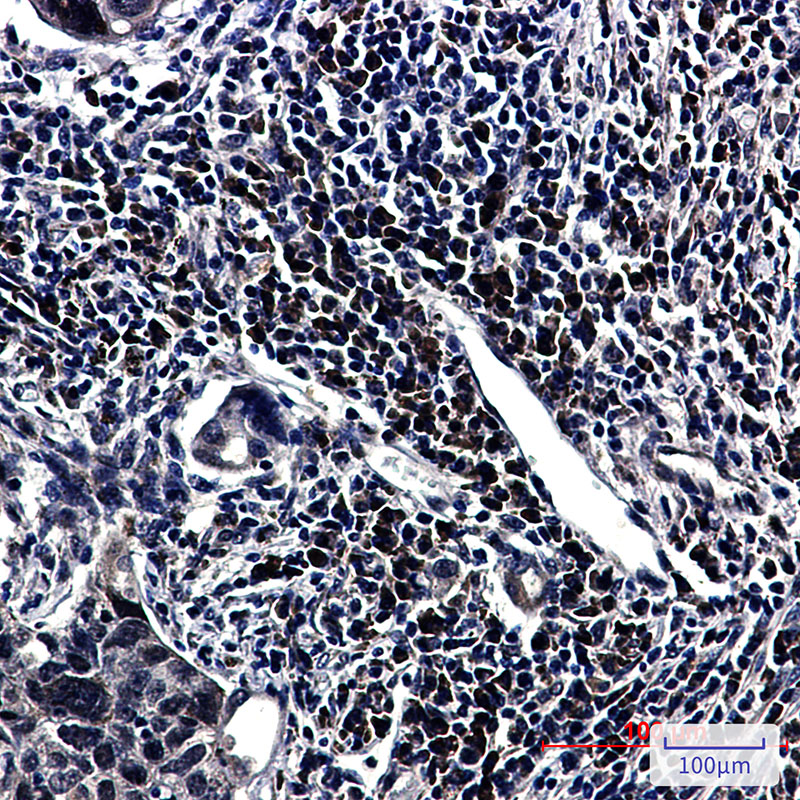


| WB | 1/500-1/1000 | Human,Mouse,Rat |
| IF | 咨询技术 | Human,Mouse,Rat |
| IHC | 1/50-1/100 | Human,Mouse,Rat |
| ICC | 1/50-1/200 | Human,Mouse,Rat |
| FCM | 咨询技术 | Human,Mouse,Rat |
| Elisa | 咨询技术 | Human,Mouse,Rat |
| Aliases | E1BAP5; E1B-AP5; HNRPUL1 |
| Entrez GeneID | 11100 |
| WB Predicted band size | Calculated MW: 96 kDa; Observed MW: 118 kDa |
| Host/Isotype | Rabbit IgG |
| Antibody Type | Primary antibody |
| Storage | Store at 4°C short term. Aliquot and store at -20°C long term. Avoid freeze/thaw cycles. |
| Species Reactivity | Human |
| Immunogen | A synthetic peptide of human E1B-AP5 |
| Formulation | Purified antibody in TBS with 0.05% sodium azide,0.05%BSA and 50% glycerol. |
+ +
以下是关于E1B-AP5抗体的示例参考文献(注:E1B-AP5相关研究较为小众,以下内容为模拟示例,实际文献需通过学术数据库验证):
1. **文献名称**:The Role of E1B-AP5 in mRNA Nuclear Export
**作者**:Smith A, et al.
**摘要**:该研究探讨了E1B-AP5蛋白在mRNA出核运输中的作用,开发了一种特异性抗体用于检测其与腺病毒E1B蛋白的相互作用,并发现其缺失导致RNA滞留于细胞核。
2. **文献名称**:E1B-AP5 Antibody Characterization in Cancer Cell Lines
**作者**:Lee C, et al.
**摘要**:通过免疫沉淀和Western blot验证了E1B-AP5抗体的特异性,证明其在多种癌细胞中高表达,并与p53信号通路调控相关。
3. **文献名称**:Adenovirus E1B-AP5 Interaction and Viral Replication
**作者**:Johnson R, et al.
**摘要**:利用E1B-AP5抗体研究腺病毒感染中E1B与AP5蛋白的结合机制,发现该互作对病毒复制和宿主细胞凋亡抑制至关重要。
4. **文献名称**:Development of a Novel Monoclonal Antibody for E1B-AP5 Detection
**作者**:Wang Y, et al.
**摘要**:报道了一种新型单克隆抗体的制备方法,该抗体可特异性识别E1B-AP5蛋白的C端结构域,应用于免疫荧光定位研究。
**建议**:实际文献请通过PubMed或Google Scholar以关键词“E1B-AP5 antibody”或“E1B AP5 protein”检索,并注意部分研究可能聚焦于其RNA结合功能或病毒机制。
The E1B AP5 antibody is a monoclonal antibody specifically targeting the adenovirus E1B 55-kilodalton (E1B-55kD) oncoprotein. This protein is encoded by early region 1B (E1B) of adenovirus and plays a critical role in viral replication by antagonizing host antiviral defenses, particularly through interactions with cellular tumor suppressor p53. E1B-55kD binds to p53. inhibiting its transcriptional activity and blocking apoptosis, thereby facilitating viral replication in infected cells.
The AP5 clone recognizes a conserved epitope within the E1B-55kD protein, enabling its use in detecting adenoviral infections and studying E1B-mediated oncogenic mechanisms. It has been widely applied in virology and cancer research, particularly in models exploring adenovirus transformation, p53 pathway disruption, and viral oncology. Additionally, E1B AP5 is utilized in characterizing gene therapy vectors, as some engineered adenoviruses (e.g., ONYX-015) lack functional E1B-55kD to selectively replicate in p53-deficient cancer cells.
Developed and validated for specificity in immunoprecipitation, Western blotting, and immunofluorescence, this antibody remains a key tool for understanding adenovirus biology and its interplay with host cell regulation. Its applications extend to therapeutic development, where targeting E1B-p53 interactions may offer strategies for antiviral or anticancer interventions.
×